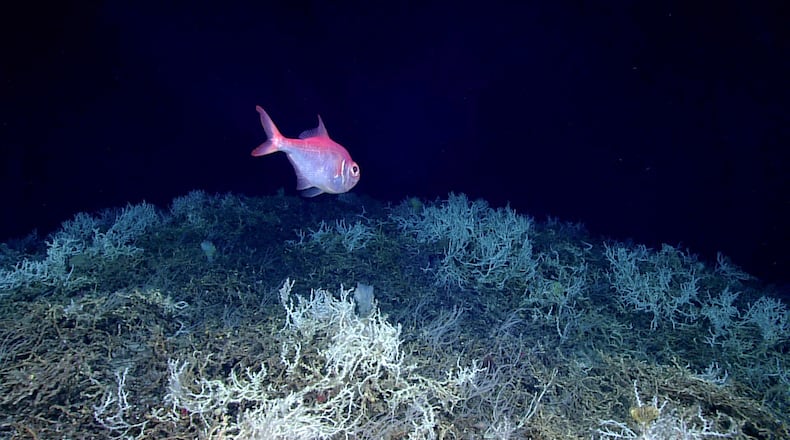The depth of our ocean goes well beyond measurements in nautical miles or leagues beneath the sea. There is profound historical and ecological significance to the region off the southeastern coast that is of a magnitude only few can imagine.
A decade of oceanographic mapping of the Blake Plateau, which sits approximately 200 miles offshore of Georgia, has recently revealed it as the largest deep-sea coral habitat on earth. This biodiversity hot spot provides habitat and food for fish, octopuses, whales and much more. But there is greater significance to this area than just its ecological wonder. The deeper reaches of the plateau provide a refuge for deep-sea coral communities in a warming world.
Credit: Handout
Credit: Handout
Credit: Edwards, Leslie
Credit: Edwards, Leslie
Credit: Handout
Credit: Handout
This deep-sea landscape that runs below the Gulf Stream embodies stories about maritime and African American history hearkening back hundreds of years. We are only on the surface of what this place can tell us. We must dive deeper into it to fully understand its relevance.
In the Gullah/Geechee Nation, the proverb “De wata bring we and de wata gwine tek we bak” is often heard. Wading back into the water to face the Motherland from which many of the ancestors of native Gullah/Geechees came would require a trip across the Blake Plateau. For many, the final stage of the “Middle Passage” tragically ended over the Blake Plateau. Captured Africans were thrown overboard from enslavement ships traversing the waters of Blake Plateau before calling into ports in America and the Caribbean, making the Blake Plateau a deep-sea graveyard for those who perished, as well as a sacred space for their descendants to honor and remember them.
The Gulf Stream over the Blake Plateau was also an ocean highway for trade, commerce and war for half a millennium. Spanish explorers and convoys sailed over it to return to Spain in Colonial times. Early American traders traversed it in both directions, connecting New England ports with the Caribbean and the Gulf of Mexico. The offshore waters of the Gulf Stream were actively fished, and whalers hunted in its waters from the 18th through the 20th centuries. Packet ships carried European immigrants to New Orleans in the 19th century. Slave ships brought unwilling captives to southern and Gulf ports. The growing economic strength of the United States was bolstered by ships under sail and steam that carried merchandise and commodities such as cotton, manufactured goods, sugar and lumber.
A number of these vessels, including two of the greatest maritime disasters of the 19th century when hurricanes sank steamships crowded with hundreds, rest on the seabed of the Blake Plateau. As a highway for trade, it was also a battlefield during World War II. The Battle of the Atlantic between Allied warships and German U-boats led to multiple shipwrecks, including the oil tanker SS Bloody Marsh, recently discovered on the Blake Plateau. On nearby Blake Ridge, a small coastal fishing craft, possibly crewed by enslaved or free African Americans, was also found on another deep-sea mission of science and exploration. These ships are tangible pieces of our cultural heritage and a reminder of the sheer importance of this part of the Atlantic in our country’s history.
The incredibly rich biodiversity of the Blake Plateau took thousands of years to develop. But it is at risk of being severely affected, if not destroyed, from increasing industrial use of our ocean. These waters have only time-limited protections from oil and gas development. With manganese and other minerals found on the plateau’s seafloor, the area is also at risk for deep-seabed mining. Mining could generate sediment plumes that stretch for miles, and smother corals and marine life outside the immediate development zone.
Conservation measures are needed to safeguard this national environmental treasure — for now and the future. We need durable, strong protections stretching from the seafloor to the sea surface for a network of critical areas to safeguard this treasure for the future and recognize its importance to the past.
There is much to learn from the Blake Plateau. Its scientific exploration and historical stories can inform us on how to be better stewards of this remarkable resource. The uncovered stories of the Blake Plateau are part of our collective history that we should teach to current and future generations. Having these stories told can bring peace to the souls of those who never reached land and deepen our understanding of how interconnected we are to the natural environment. Important areas on the Blake Plateau should be strongly protected to ensure the cultural, spiritual and historical significance of this region remain intact and is never forgotten.
Queen Quet Marquetta L. Goodwine, is chieftess and head of state for the Gullah/Geechee Nation and founder of the Gullah/Geechee Sea Island Coalition, the premiere advocacy organization for the rights of Gullah/Geechees. Kamau Sadiki is a board member and lead instructor in the underwater archaeology documentation program of the nonprofit Diving With a Purpose. James Delgado is senior vice president of SEARCH Inc., a maritime archaeologist and former director of the National Oceanic and Atmospheric Administration’s Maritime Heritage Program.
Keep Reading
The Latest
Featured





